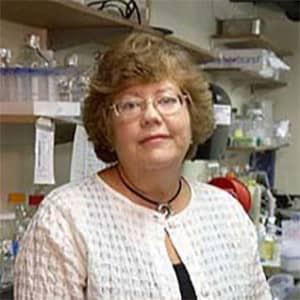Diane A. Blake, PhD
Emeritus Professor

Education & Affiliations
Biography
Dr. Blake received her B.S. in Biochemistry in 1972 from Ohio State University in Columbus, Ohio. She then moved to the University of Illinois at Urbana-Champaign to study proteoglycan biosynthesis/structure with H. Edward Conrad and received her PhD in Biochemistry in 1977. After a 4-year postdoctoral fellowship studying lectin biochemistry and glycoprotein synthesis with Irwin J. Goldstein at the University of Michigan, Ann Arbor, MI, she joined Miles Laboratories as a Research Scientist in 1981. In 1983 she took a faculty position at Meharry Medical College in Nashville, TN, where she remained for 9 years. She came to Tulane in 1993 and is now Professor of Biochemistry. Dr. Blake has published over 50 papers in the areas of glycoprotein/proteoglycan biochemistry and protein-ligand interactions. She served for 5 years as a Member of the Advisory Panel for Cell Biology for the National Science Foundation and recently was a Panel Member for their Biocomplexity initiative. She has also served on Review Panels of the Environmental Protection Agency and performed ad hoc reviews for the National Institutes of Health, the Wellcome Trust (UK), and the North Carolina Biotechnology Center. She reviews regularly for Investigative Ophthalmology and Visual Sciences and Analytica Chemistry. One area of Dr. Blake's research is focused upon a study of extracellular matrix and cell-matrix interactions. Her most recent projects have included signal transduction via extracellular matrix receptors, and research on the effects of extracellular molecules on cell migration and proliferation. She has concentrated upon those extracellular matrix molecules that influence the behavior of vascular endothelial cells. A practical outcome of her experiments has been the development of new drugs (based on extracellular matrix molecules) that inhibit the process of angiogenesis. Such angiogenesis inhibitors have applications in the control of both cancer and ocular disease. A second area of active research in Blake's laboratory is the development of antibody reagents that can be used to assess human exposure to heavy metals. Some of the antibodies she has developed for this project also have applications in cancer prognosis and therapy.
Contributions
Representative and Recent Publications:
Environmental Contaminants: Antibodies, Sensors and Toxicology
Y. Sun, B. Ban, A. Bradbury, G.A. Ansari and D.A. Blake (2016) Combining yeast display and competitive FACS to select rare hapten-specific clones from recombinant antibody libraries, Anal. Chem., 88:9181–9189. PMID:27571429.
H. Yan, N. Tang, G.A. Jairo, S. Chakravarty, D.A. Blake and R.T. Chen (2016) High-sensitivity high-throughput chip based biosensor array for multiplexed detection of heavy metals, Proc. SPIE, 9725, Frontiers in Biological Detection: From Nanosensors to Systems VIII, April 2016. doi:10.1117/12.2212731.
Y. Sun, C. A. Miller III, Thomas E. Wiese and D.A. Blake (2014) Methylated phenanthrenes are more potent than phenanthrene in a bioassay of human aryl hydrocarbon receptor (AhR) activation. Environ. Toxicol. Chem., 33:2363-2367. PMID:25043914
A.M. Lopez-Marzo, J. Pons, D.A. Blake and A. Merkoçi, (2013) All-integrated and highly sensitive paper-based device with sample treatment platform for cadmium immunodetection in waters, Anal. Chem. 85, 3532–3538. PMID:23445438
S.J. Melton, H. Yu, K.H. Williams, S.A. Morris, P.E. Long and D. A. Blake (2009) Field-based detection and monitoring of uranium in contaminated groundwater using two immunosensors, Environ. Sci. Technol., 43: 6703-6709. PMID:19764238
Drug Delivery
J. Arora, T. Ponnusamy, R. Zheng, P. Venkataraman, S.A. Raghvan, D. Blake and V. John (2015) Spatially directed vesicle capture in the ordered pores of breath-figure polymer films, Soft Matter, 11:5188-5191. PMID:26021456
E.D. Schoenberg, D.A. Blake, F.B. Swann, A.W. Parlin and R.S. Ayyala (2015) Effect of two novel sustained-release drug delivery systems on bleb fibrosis: An in vivo glaucoma drainage device study in a rabbit model. Trans. Vis. Sci. Technol., 4(3):4. PMID:26046006
M. Grabacka, P. Waligorski, A. Zapata, D.A. Blake, D. Wyczechowska, A. Wilk, H. Vashistha, R.S. Ayyala, T. Ponnusamy, V.T. John F. Culicchia, and K. Reiss (2015) Fenofibrate subcellular and tissue distribution as a rationale for the intracranial delivery through a biodegradable carrier. J. Physiol. Pharmacol., 66: 233-247. PMID:25903954.T. Ponnusamy, H. Yu, V.T. John, R.S.
Ayyala, and D.A. Blake (2014) A novel anti-proliferative drug coating for glaucoma drainages devices. J. Glaucoma, 23:526-534. PMID:23632409
N. Sahiner, D.J. Kravitz, R. Qadir, D.A. Blake, S. Haque, V.T. John, C. Margo, R.S. Ayyala (2009) Creation of a drug-coated glaucoma drainage device using polymer technology: In vitro and in vivo studies, Arch. Ophthalmol., 127:448-453. PMID:19365022
